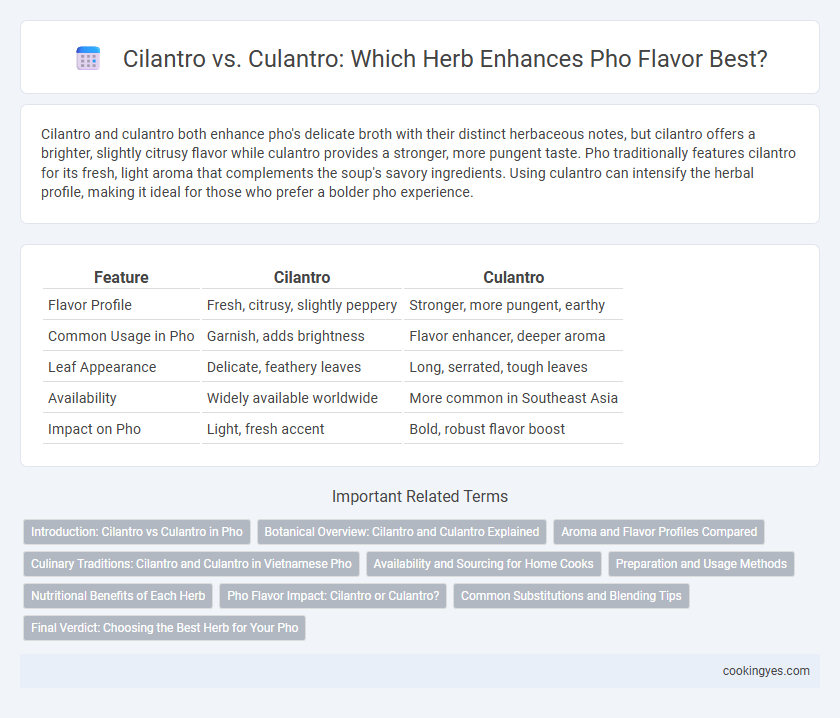Cilantro and culantro both enhance pho's delicate broth with their distinct herbaceous notes, but cilantro offers a brighter, slightly citrusy flavor while culantro provides a stronger, more pungent taste. Pho traditionally features cilantro for its fresh, light aroma that complements the soup's savory ingredients. Using culantro can intensify the herbal profile, making it ideal for those who prefer a bolder pho experience.
Table of Comparison
| Feature | Cilantro | Culantro |
|---|---|---|
| Flavor Profile | Fresh, citrusy, slightly peppery | Stronger, more pungent, earthy |
| Common Usage in Pho | Garnish, adds brightness | Flavor enhancer, deeper aroma |
| Leaf Appearance | Delicate, feathery leaves | Long, serrated, tough leaves |
| Availability | Widely available worldwide | More common in Southeast Asia |
| Impact on Pho | Light, fresh accent | Bold, robust flavor boost |
Introduction: Cilantro vs Culantro in Pho
Cilantro and culantro are two distinct herbs often debated for enhancing pho flavor, with cilantro offering a fresh, citrusy note and culantro providing a stronger, more pungent aroma. Pho recipes vary by region, influencing herb preference, where northern Vietnamese pho typically favors cilantro, while southern versions may include culantro for a bolder taste. Both herbs contribute essential layers to the pho broth, balancing the dish's savory and aromatic profile.
Botanical Overview: Cilantro and Culantro Explained
Cilantro (Coriandrum sativum) and culantro (Eryngium foetidum) are distinct herbs commonly used in pho for their unique flavor profiles. Cilantro features delicate, feathery leaves with a bright, citrusy taste, while culantro has thicker, serrated leaves and a stronger, more pungent aroma. Both herbs belong to the Apiaceae family but differ botanically in leaf structure and flavor intensity, impacting the authentic pho experience.
Aroma and Flavor Profiles Compared
Cilantro offers a bright, citrusy aroma with a fresh, slightly peppery flavor that enhances pho's vibrant taste. Culantro, in contrast, delivers a stronger, more pungent aroma with earthy, herbal notes that add depth and complexity to the broth. The combination or substitution of these herbs in pho influences the overall sensory experience by balancing freshness and intensity in the flavor profile.
Culinary Traditions: Cilantro and Culantro in Vietnamese Pho
Cilantro and culantro play distinct roles in Vietnamese pho, each contributing unique aromatic qualities to the broth. Cilantro offers a fresh, citrusy flavor that enhances the pho's lightness, while culantro delivers a stronger, more pungent aroma, reflecting regional culinary traditions. The balanced use of both herbs underscores the complexity and depth characteristic of authentic Vietnamese pho.
Availability and Sourcing for Home Cooks
Cilantro is widely available in most grocery stores and markets, making it the go-to herb for home cooks preparing pho. Culantro, although offering a stronger and more authentic flavor, can be harder to find outside of specialty Asian or Latin American stores. Sourcing culantro may require visiting farmers' markets or purchasing from online suppliers, which can influence convenience and accessibility for home cooks.
Preparation and Usage Methods
Cilantro's delicate leaves are typically added fresh as a garnish, enhancing pho with a bright, citrusy flavor when sprinkled just before serving. Culantro, with its stronger, more pungent taste, is often chopped finely and incorporated earlier in the broth preparation to infuse a deeper herbal aroma. Both herbs complement pho uniquely, with cilantro used mainly for fresh, last-minute flavor bursts and culantro providing a robust base layer of taste.
Nutritional Benefits of Each Herb
Cilantro contains high levels of antioxidants, vitamins A, C, and K, supporting immune function and skin health, while adding a fresh, citrusy note to pho. Culantro offers a stronger aroma and is rich in iron, calcium, and carotenoids, aiding bone health and providing anti-inflammatory benefits. Both herbs enhance pho's flavor profile with distinct nutritional advantages, making them valuable additions depending on dietary needs and taste preferences.
Pho Flavor Impact: Cilantro or Culantro?
Cilantro and culantro both contribute distinct herbal notes to pho, with cilantro offering a bright, citrusy flavor that enhances freshness, while culantro provides a stronger, more pungent aroma that deepens the broth's complexity. Pho recipes often favor cilantro for its lightness, but culantro's intense flavor can intensify the overall savoriness of the soup. The choice between cilantro and culantro significantly influences the pho's final taste profile, balancing brightness and depth depending on regional preferences.
Common Substitutions and Blending Tips
Cilantro and culantro both contribute distinct flavors to pho, with cilantro offering a bright, citrusy note and culantro providing a stronger, more pungent taste. Common substitutions often blend small amounts of culantro with cilantro to balance intensity without overpowering the traditional pho broth. Using a mix of fresh cilantro leaves and finely chopped culantro stems enhances the aromatic complexity while maintaining the signature pho flavor profile.
Final Verdict: Choosing the Best Herb for Your Pho
Cilantro offers a fresh, citrusy flavor that brightens pho with its delicate leaves and vibrant aroma, making it a popular choice in traditional Vietnamese recipes. Culantro provides a more pungent, robust taste with a stronger, slightly spicy undertone that enhances the broth's depth and complexity. For an authentic pho experience, cilantro is generally preferred, but culantro works well for those seeking a bolder, earthier herb profile.
Cilantro vs Culantro for Pho Flavor Infographic

 cookingyes.com
cookingyes.com